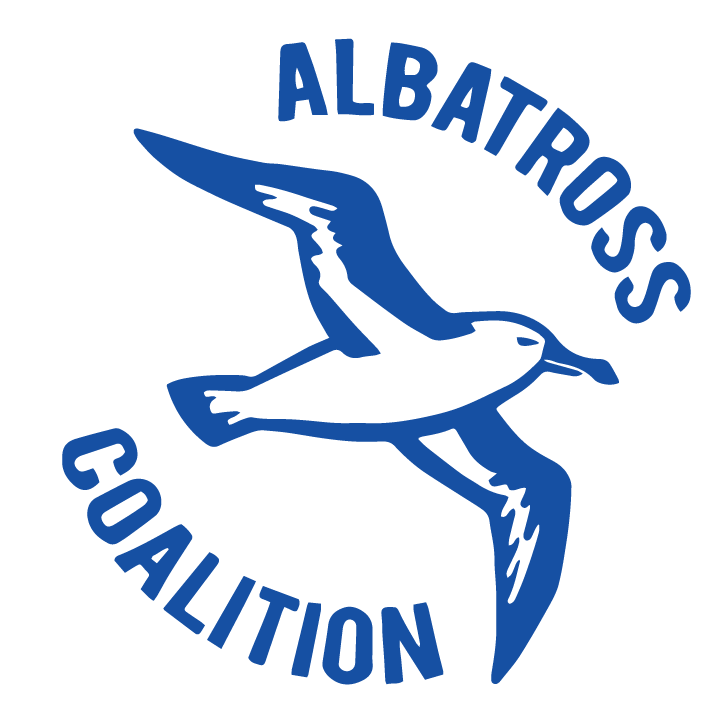Campaign
The Save the Albatross Coalition (STAC) is a bootstrap campaign dedicated to stopping the tide of single-use disposal items polluting our oceans and killing our wildlife, in particular the iconic Pacific Albatross.
Our current focus is on plastic bottles and bottle caps, which combined are the most frequent items found at beach and watershed clean-ups.
STAC Active Campaigns
Leash the Lid Campaign
Objective: Eliminate loose bottle caps that become ocean debris and kill marine wildlife
Key Initiatives:
- California Assembly Bill 319 – Prohibits retailers from selling beverages in bottles with untethered caps by 2020 (authored by Assembly Member Mark Stone)
- Leash the Lid Toolkit – Resources for advocacy including legislative letter templates, city council resolution guides, and media materials
- Corporate Engagement – Direct dialogue with Coca-Cola, PepsiCo, and Nestlé Waters on tethered cap adoption
- Public Advocacy – YouTube video campaign and Change.org petition with nearly 92,000 signatures
Take Action:
- Share the Leash the Lid – Support AB-319 video
- Sign the Tell Coke and Pepsi to Leash their Lids! petition
- Use our Leash the Lid Toolkit for local advocacy
Fundraising Campaign
Support STAC’s Mission – Our Indiegogo Campaign helps fund lobbying efforts and website maintenance.
The Problem: By the Numbers
According to Coastal Cleanup Day data spanning 26 years:
- Plastic bottle caps rank as the 4th most prevalent cleanup item
- Over 1 million plastic bottle caps (1,044,414) have been collected and recorded
- Uncollected caps join the “plastic soup” in oceans where they’re ingested by seabirds, especially albatrosses
“It’s time to leash the lid! In the 1970s the pull-tab or ‘pop top’ on aluminum cans was replaced by the much safer and environmentally friendlier ‘sta-tab’, and is still in use today. We did it then, we can do it again.”
— Paula White, The Watershed Project
Coalition Partners & Initiatives
STAC works alongside these organizations advancing complementary zero-waste and ocean protection goals:
GRRN/Zero Waste USA
Ocean Protection Campaign – Partnership with Cordell Banks National Marine Sanctuary creating campus stewardship projects using the Litterati platform for litter tracking and community action.
Zero Waste Brain Trust (ZWBT)
Mission – Informal coalition of resource management professionals developing waste-free systems benefiting all stakeholders.
Zero Waste International Alliance
Brand Standards – Establishing worldwide Zero Waste definitions and principles, distinguishing true Zero Waste from “Zero Landfill” approaches that rely on incineration.
COOL Initiative
Compostable Organics Out of Landfills – Preventing methane emissions by diverting organic waste from landfills to composting systems.
Resources
STAC Tools & Materials
- Leash the Lid Toolkit – Advocacy resources, letter templates, and guides
- Leash the Lid Video – Campaign video supporting AB-319
- Change.org Petition – Tell major corporations to leash their lids
- STAC Indiegogo Campaign – Support our lobbying and outreach efforts
Legislative & Policy
- California Assembly Bill 319 – Tethered bottle cap legislation
- Ocean Conservancy Beach Cleanup Data – Cleanup statistics and trends
Partner Organizations
- Cordell Banks National Marine Sanctuary – Winged Ambassadors curriculum
- The Watershed Project – Coastal cleanup data and analysis
- Litterati Platform – Campus debris tracking technology
- COOL Initiative – Compostable Organics Out of Landfills
Research & Data
- Plastic Poses a Growing Threat to Seabirds – NY Times interactive report
- Threat Of Plastic Pollution To Seabirds Is Global, Pervasive and Increasing – PNAS research study
- Zero Landfill is not Zero Waste – Eric Lombardi analysis (PDF)
